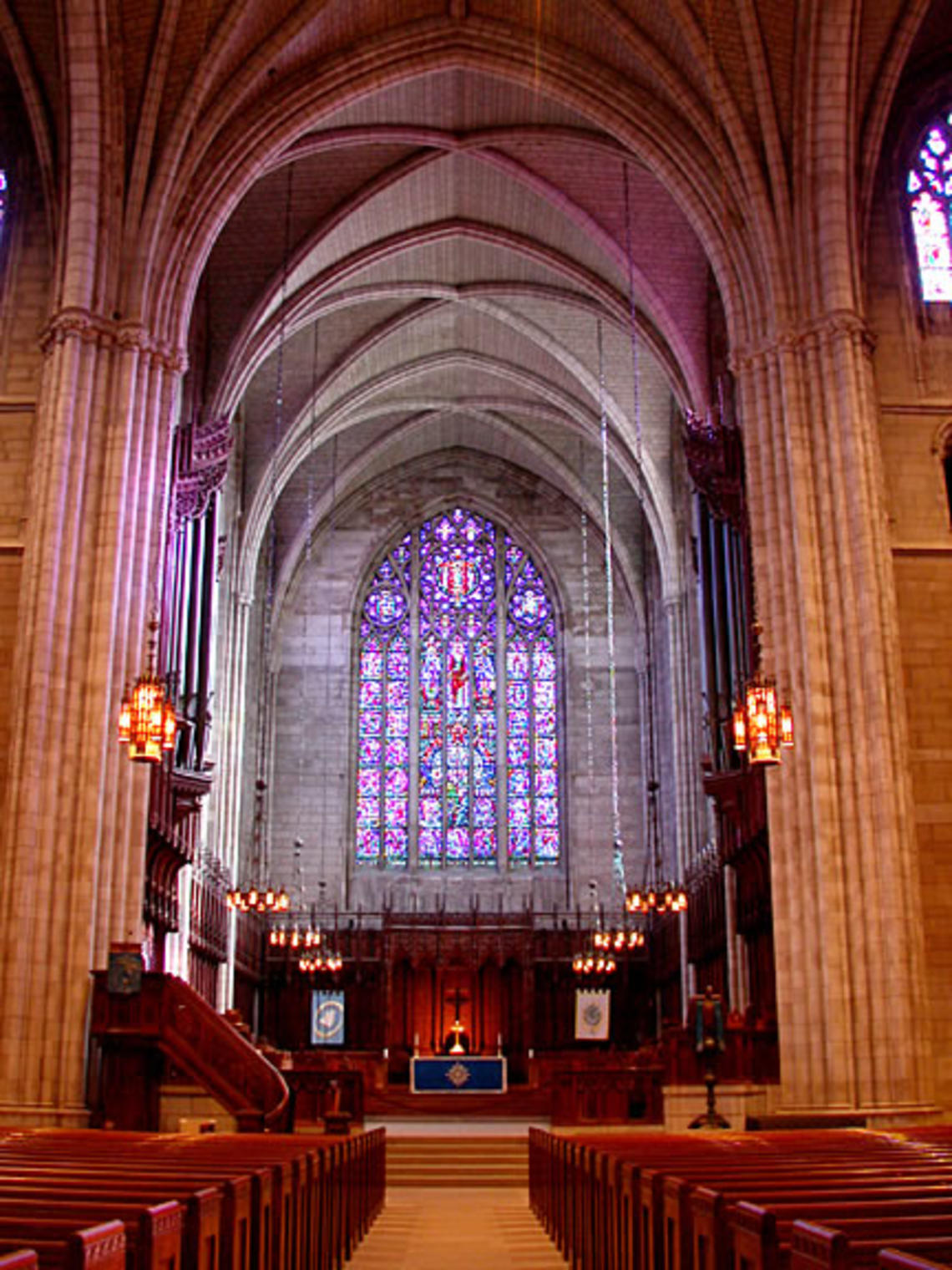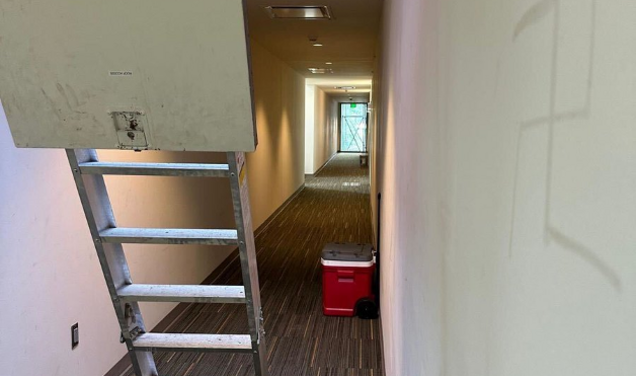
When last we left Firestone Plaza a couple months back, we noted in passing that the great open-stack library, the very core of Princeton’s undergraduate ethos, took its own sweet time getting built before opening in 1948, especially given the almost hopelessly overburdened state of the preceding Pyne Library as early as 1920. Certainly the practical hurdles to such an undertaking between October 1929 and the end of World War II are self-apparent, but what of the nine years or so prior to Black Thursday?

New campus building in the Jazz Age showed alternative priorities. With Ralph Adams Cram as campus architect, new Gothic dorms went up everywhere: Laughlin-1901, Henry, Foulke, Pyne Hall, Lockhart, 1903 Hall, all came from this era. The nascent sciences did well: Eno, Frick, and the new Green Hall went up (more Gothic). Even the arts were represented: McCormick – and an enlargement after only five years – and McCarter Theatre were built (MORE Gothic). And most tellingly, while scholars got scalded searching for books piled in steam tunnels under Pyne Library, a hundred yards away, Princeton built the second-largest college chapel in the world.
You, being the discriminating historian that you are, will recall that every president of the University from 1746 until 1972 was either a Presbyterian minister or the son of one. This 226-year pattern is known in the technical jargon of the historian trade as “not a coincidence.” But the last actual parson to be president, John Grier Hibben, valedictorian of the Class of 1882, happened to be in office in 1920 when the quirky but much loved Marquand Chapel burned to the walls. Given two humongous options, Hibben decided that addressing the library needs could wait (although he certainly didn’t foresee delaying until 1948) while the University fast-tracked filling its sudden spiritual gap and made a statement in the process. A large statement. He and Cram put together the meticulous design for a $2 million (perhaps $30 million today) colossus with much of the stone, carving, stained glass, and musical richness of the great cathedrals (REALLY GOTHIC), then went about selling it to the trustees and well-heeled alums. This was not merely a product of religious fervor; it had, in Hibben’s mind, a highly concrete immediate goal.
He wanted to eliminate compulsory chapel attendance.
As this idea may not flow very smoothly through the logic buffer of you, the discriminating historian, a few explanatory words are in order here. Hibben’s concept is really a very powerful one: The rationalism of the academy and the spiritualism of true Christianity are compatible, even mutually supportive. Displayed in many ways, great and small, in the Chapel, this is most explicit in the awe-inspiring stained glass. The windows on the north side of the building retell the story of the Christian Bible (with explicit reference to the Old Testament roots of Judaism and Islam, by the way). The windows on the south represent the teachings of the University (the top rank) and the teachings of Christ (the lower rank). Aside from much breathtaking art and symbolism (to include even Emily Dickinson), this layout results in an intentional counterpoint of creation and evolution. Really. In the upper west corner of the north wall, the days of creation are indicated by separate circles surrounding Adam and Eve. Directly opposite, on the south wall, the sciences are depicted with great proponents from Aristotle to professor Joseph Henry, in the self-same circles. Clearly, they have complementary and equivalent roles.
Not content simply taking the time to conjoin Genesis and Darwin, Hibben in another holistic gesture equates and glories equally in the great literary traditions of Roman Catholicism – namely Malory’s Le Morte D’Arthur and Dante’s Inferno – and the Protestants in Bunyan’s Pilgrim’s Progress and Milton’s Paradise Lost. These are illustrated in a wildly intricate and imaginative quartet of arches on either side of the Milbank Choir (the woodcarved area behind the pulpit) where, perversely, they’re almost impossible to see unless you go looking for them.
So Hibben hoped these powerful physical arguments of spirituality, harmony, and ecumenism (plus practical accoutrements like naming a dean of the chapel to preach instead of the president) would prompt the students to gladly participate in and gain wisdom from their experience in chapel services, and so any need for compulsion would wither away. This might lead you, the discriminating historian, to conclude that either the entire Class of 1882 somehow lacked original sin, or that his view of the species was a tad optimistic. In any case, he clearly hadn’t seen any Clara Bow movies.
But the great Chapel opened 80 years ago to much amazement, albeit amid comments about being a very expensive tribute to anti-materialism. And Hibben’s robust theology, perhaps wasted on the undergrads, was enshrined for us and many generations to follow.
Has anyone paid attention, has any of this sunk in? One fascinating answer came in the guise of enforced maintenance; by 2000, the wear and tear of the industrial age had taken a toll on the great stonework. More inanely, “advances” in lead purification in the early 20th century had resulted in windows whose glass was perfect but whose latticework already was falling apart. The result was a two-year restoration of the building, taking fully half as long and costing $10 million, a third as much in today’s dollars as the entire original project. The stained-glass work alone is described variously as the largest glass restoration in North America since 1970, or in the Western Hemisphere ever; obviously so big that nobody’s even sure.
At the time, as an old Gothic-cathedral nut and curious about other Princetonians’ take on the situation, I went out of my way to provoke comments from friends, acquaintances, visitors; I wrote notes to alumni listservs, I goaded faculty, I prodded to find whether people were ill at ease with such an expenditure on a religious edifice by a now multicultured, multifaithed 21st-century Internet-based University. Honest to Hibben, I never unearthed one complaint. There seems, in the subconscious value system of Princeton, an understanding of the spirituality of the Chapel, however a given individual might perceive it, and its inherent value to the community. In such an egotists’ paradise, that’s a small miracle in itself.
VIRTUAL NOTE: The very talented and generous Matthew Milliner GS has created a new history Web site for the Chapel — http://web.princeton.edu/sites/chapel/history.html — detailing a great deal of its back story, symbology, and philosophy. With many illustrations and precise citations of all the prior fine works about the Chapel, it is a treasure trove, and also a starting point for your own tour; it has a printable pdf guide and a series of self-paced MP-3 audio files http://web.princeton.edu/sites/chapel/tours.html for your touring and gesticulating pleasure. Be sure to bring your binoculars!









No responses yet